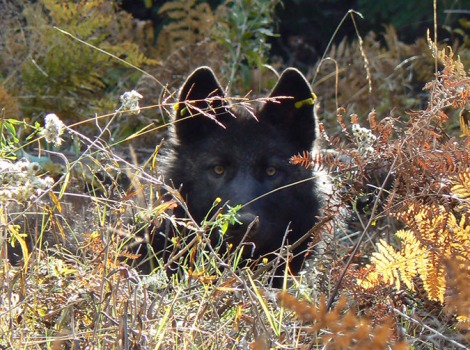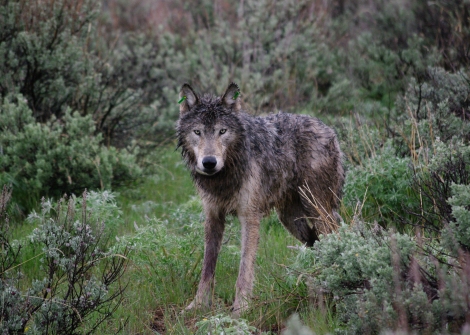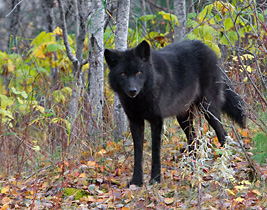
November 1, 2015
Oregon is ready to delist wolves.
Anyone who’s read the Oregon wolf “management plan” could see this coming a mile away. There was major push-back against “the plan” in 2010 because the number of breeding pairs needed to reach delisting was and is ridiculously low. So here we are, five years later and Oregon’s woefully inadequate wolf “management plan” is ready to kick in.
Please attend the ODFW meeting in Salem, Oregon on November 9th to speak out against the plan and delisting.
“ODFW staff believe gray wolves have met the criteria to be delisted from the state Endangered Species Act (ESA) and will recommend this action to the Fish and Wildlife Commission at their Nov. 9th meeting in Salem.
The meeting begins at 8 a.m. at ODFW Headquarters, 4034 Fairview Industrial Drive SE, Salem. It is open to the public and public testimony will be accepted during the meeting. Consideration of wolf delisting is the only item on the agenda. Written comments will also be accepted until Friday Nov. 6 at 5 p.m. and can be sent to odfw.commission@state.or.us More information about the meeting is available at” http://www.dfw.state.or.us/agency/commission/minutes/15/11_november/index.asp
===
Washington state has a far superior wolf “management plan”.
To reclassify from state threatened to state sensitive status: 12 successful breeding pairs present for 3 consecutive years, with 4 successful breeding pairs in each of the three recovery regions.
To delist from state sensitive status: 15 successful breeding pairs present for 3 consecutive years, with 4 successful breeding pairs in each of the three recovery regions and 3 successful breeding pairs anywhere in the state.
In addition to the delisting objective of 15 successful breeding pairs distributed in the three geographic regions for 3 consecutive years, an alternative delisting objective is also established whereby the gray wolf will be considered for delisting when 18 successful breeding pairs are present, with 4 successful breeding pairs in the Eastern Washington region, 4 successful breeding pairs in the Northern Cascades region, 4 successful breeding pairs distributed in the Southern Cascades and Northwest Coast region, and 6 anywhere in the state.
http://wdfw.wa.gov/publications/00001/
===
But Oregon only requires four breeding pairs for three consecutive years in Eastern Oregon to “be considered for statewide delisting”. In Western Oregon, the goal is also four breeding pairs. The plan is divided into three parts. Phase three states:
“Under Phase 3 a limited controlled hunt could be allowed to decrease chronic depredation or reduce pressure on wild ungulates if confirmed wolf predation leads to declines in localized herds.”
Even in a state as progressive as Oregon, wolves are not safe. They will eventually be subjected to a wolf hunt and probably much sooner than everyone thinks. This proposed delisting will open a wolf Pandora’s box that will never close.
But let’s be blunt, the ONLY reason wolf management plans exist is to placate ranchers and hunters. Wolves don’t need managing. What we’ve done, by bringing wolves back from the brink in the lower 48, is place them in a cage they can’t escape. Wild wolves are not free. As I type this wolves in Montana and Idaho are being hunted and trapped. And if the USFWS has their way, all wolves across the lower 48, will lose their ESA protections.
Rick Bass put it most eloquently, when describing the untenable conditions we force wolves to live under:
MAY WE NEVER BE JUDGED BY ANYTHING SO HARSHLY OR HOLD TO AS STRICT A LIFE OR UNREMITTING OF BORDERS AS THE ONES WE TRY TO PLACE ON & AROUND WOLVES…Rick Bass
Wolves have been poached in almost every state they disperse to with the exception of California. Remember Echo, the little wolf who traveled hundreds of miles to the North Rim of the Grand Canyon, only to be shot by a trophy hunter, using the “coyote excuse“? This is one of the deadliest threats to dispersing wolves Those two words, give the shooter a perfect alibi. It’s “he said, he said”. Or “she said, she said”. The wolf is dead, it’s the shooter’s word that counts.The sad stories go on and on, we all know them. And of course, even though wolves are still “supposedly protected” by the ESA across the continental US the USFWS does virtually nothing to curb or stop poaching. Poaching investigations go nowhere, and most poachers go unpunished. The “coyote excuse” is accepted again and again by the USFWS as gospel. But we all know the real reason why there are few prosecutions of wolf poachers, the USFWS isn’t interested in wolves dispersing out of the Northern Rockies/Pacific Northwest or Great Lakes, to reclaim lost habitat. Wolves currently inhabit less than 5% of their former range. Yet does it come as a surprise that wolf dispersal has been stopped cold outside of the areas I mentioned? The odds are stacked against them as they face the likes of Wildlife Services, poachers, hostile state governments, hunters and ranchers. Wolves are trapped by man-made boundaries they dare not cross. Boundaries that hold no meaning for them but ultimately contribute to their deaths.
Wolves are unique, sentient beings, incredibly smart wild dogs devoted to their families. Yet hunted wolf populations are subjected to a deadly game of annual Russian Roulette, where wolf mothers, fathers, puppies and pack mates are brutally killed in the name of “management”.
Once pack structure is disrupted, it’s very difficult to keep the family together, as the plight of the alpha male of the Lamar Canyon Pack (755m) demonstrates. After losing his mate, the iconic, 06 Female, to a hunter’s bullet in 2012, he’s still attempting to restore his pack, trying to connect with his FOURTH potential mate. We have Rick Lamplugh, the author of In The Temple of the Wolves: A Winter’s Immersion In Wild Yellowstone, for shining a light on wolf 755m’s sad story.
One Bullet Kills an Entire Pack
Wolf 755M (right) was the alpha male of the Lamar Canyon Pack seen here with 889F (left) the fourth wolf with whom he has tried to restart a pack after his mate was shot and killed outside Yellowstone Nat’l Park.
The results of legal wolf hunt are presented to the public as palatable statistics. Officials tell us, for example, that in the 2012-2013 hunts outside Yellowstone National Park twelve park wolves were killed. Six were collared wolves that–when alive–provided valuable research data. One of those collared wolves was the famous alpha female of the Lamar Canyon pack, dubbed “06” by wolf watchers.
===
Can you imagine, in human terms, someone randomly killing your mother, father, or children and still remaining a whole, functional family? The answer is obviously no. But because wolves are at the mercy of fish and game agencies who manage wildlife for hunters, the wolf’s family structure and what happens to those bonds is never considered. A wolf, is a wolf is a wolf as far as they’re concerned. Knock one down and they’ll just make more. How primitive, how insensitive, how backward. And that is what the wolves in Oregon are facing and what Montana and Idaho wolves are experiencing. And what the wolves in the Great Lakes were suffering until a federal judge placed them back on the Endangered Species List in December 2014. Don’t expect them to remain protected if the Obama USFWS has their wayy.
To treat wolves as disposable, never considering their family bonds and tight social order, is a grave injustice. BUT as long as they are “managed” under the iron fist of fish and game agencies, who DO NOT represent their interests, they will remain prisoners in their ancestral home.
===
ODFW Believes Gray Wolf Should Be Delisted
Salem, Ore.— ODFW staff believe gray wolves have met the criteria to be delisted from the state Endangered Species Act (ESA) and will recommend this action to the Fish and Wildlife Commission at their Nov. 9th meeting in Salem.
The meeting begins at 8 a.m. at ODFW Headquarters, 4034 Fairview Industrial Drive SE, Salem. It is open to the public and public testimony will be accepted during the meeting. Consideration of wolf delisting is the only item on the agenda. Written comments will also be accepted until Friday Nov. 6 at 5 p.m. and can be sent to odfw.commission@state.or.us More information about the meeting is available at http://www.dfw.state.or.us/agency/commission/minutes/15/11_november/index.asp
Wolf management in Oregon is guided by the Wolf Plan, which was originally crafted in 2005 by a broad group of stakeholders balancing competing interests. The Plan called for initiating a process to consider delisting wolves from the state ESA when eastern Oregon had a population of four breeding pairs of wolves for three consecutive years, an objective met in January 2015.
State ESA law gives the Fish and Wildlife Commission authority to list and remove species from the Endangered Species List.
http://www.mycentraloregon.com/2015/10/29/odfw-believes-gray-wolf-should-be-delisted/
===
Eastern Oregon Wolves Could Be Facing Delisting In 2015

OPB | Sept. 16, 2014 2:21 p.m. | Portland
Gray wolf populations are on the rise in Oregon, but that may not necessarily be good news for the animals.
The Statesman Journal reports that the state may have enough potential wolf couples in 2015 for the minimum requirements to delist the animal.
“We were told in the beginning that when wolves first came to the county, we were waiting for that day,” said Todd Nash, wolf committee chairman for the Oregon Cattleman Association, in an interview with the newspaper.
According to Oregon’s Endangered Species Act, the state Department of Fish and Wildlife must verify four breeding pairs in eastern Oregon for three consecutive years.
In 2012, there were six pairs and last year the organization located four pairs. It’s predicted that 2014’s count won’t be complete until early next year, but early reports show more than four couples.
By removing wolves from the state’s endangered species list, ranchers would be permitted to use lethal force to defend their animals in more situations.
According to ODFW , shooting a wolf is considered a misdemeanor, which carries a maximum penalty of $6,250 fine and a year in jail.
https://howlingforjustice.wordpress.com/?p=27382
===
Help Change Oregon’s Wolf Management Plan
June 21, 2010

Oregon Yearling Wolf Killed By Wildlife Services 2009
Guest Post by Katie, Oregon resident and wolf advocate.
June 21, 2010
The Oregon Wolf Management Plan is currently under a 5-year review and the Oregon Department of Fish and Wildlife is accepting comments from the public until June 30th. However, before I tell you about the plan and its obstacles, here is a brief history of the Oregon wolves.
In Oregon, the last gray wolf was eradicated from the state by the 1940s. It was almost 60 years before another one was seen. The first wolf to migrate to the state in 1999 was recaptured and sent back to Idaho. In 2000, two more gray wolves made the journey, but sadly they were both killed; one by a car and one by bullet. The fact that wolves were returning was undeniable, so the state decided they needed a plan. The ODFW sat down with wolf advocates and livestock owners to decide what should be done. Though the livestock owners may have gotten more say in the plan, wolf advocates seemed glad to simply be getting wolves back in the state. The result was a wolf management plan that everyone agreed on. Oregon became one of the first states to willingly open the doors for gray wolves to return.
In 2008, a female Idaho wolf was located in Oregon using the signals from her radio collar. The gray wolf was identified as “B-300”. To bring more attention to wolf recovery in Oregon, the members of a local environmental group, called Oregon Wild, nicknamed the wolf “Sophie”. Eventually finding a mate, Sophie soon became the alpha female of the largest pack in Oregon with 10 wolves total; the Imnaha Pack. Another pack of four wolves was also discovered in 2008. Together, the two packs made up Oregon’s known gray wolf population of 14 individuals.
The plan seemed perfect. Wolves were returning and things seemed to be going well. However, in 2009, two yearling wolves were convicted of killing 29 domestic animals from five different incidents. When non-lethal techniques failed, Wildlife Services was sent in and killed both wolves. Personally, I don’t blame the wolves, they were just pups. Being too young to hunt elk, it was either that or starve. They had no known pack and just seemed to have traveled into Oregon from Idaho on their own. It is possible that their family was killed by a rival pack, but I believe it is more likely that they were killed for “management” purposes.
Now, in 2010, history seems to be repeating itself as two more wolves are being targeted by WS. With only 14 known wolves in the entire state, killing two individuals would be a huge loss. ODFW has also issued seven kill permits to local ranchers, which could spell disaster for such a fragile population.
CURRENT PLAN
Oregon current Wolf Management Plan included three phases for population recovery:
PHASE ONE
“Wolves may be considered for statewide delisting once the population reaches four breeding pairs for three consecutive years in eastern Oregon…. The plan calls for managing wolves in western Oregon as if the species remains listed until the western Oregon wolf population reaches four breeding pairs.”
This means when there are four packs in eastern Oregon and four in western Oregon, wolves will be stripped of ESA protection statewide.
The average gray wolf pack size is about 8 wolves. If packs in Oregon follow the norm, then roughly 64 wolves will be present when they are delisted. A recent study suggests Oregon could support up to 2200 wolves and still maintain a healthy ecosystem. I don’t know about you, but 64 wolves doesn’t sound like recovered to me.
PHASE TWO:
“Once the wolf is delisted, more options are available to address wolf-livestock conflict. While there are five to seven breeding pairs, landowners may kill a wolf involved in chronic depredation with a permit. Five to seven breeding pairs is considered the management population objective, or Phase 2.”
Five to seven breeding pairs? Oregon currently has two breeding pairs and seven landowners have been given permits to kill wolves. Again, five to seven breeding pairs is 40-56 wolves if they are the average pack size.
PHASE THREE
“Under Phase 3 a limited controlled hunt could be allowed to decrease chronic depredation or reduce pressure on wild ungulates if confirmed wolf predation leads to declines in localized herds.”
Sound familiar? Idaho and Montana initiated hunts mere months after wolves were delisted. The difference is there were 1500 wolves in Montana and Idaho when the first hunts began. In Oregon the hunt could start with less than 100.
As you can see, the Oregon Wolf Management Plan is weak and gives livestock owners plenty of tools to deal with wolf depredation. However, the Oregon Cattle Association wants more power. Since the plan is under a 5-year review, OCA is suggesting changes to the plan that will suit the cattle industry, not wolves.
OCA’S TESTIMONY
1. Delisting rules (combine the whole state and begin delisting when there are 4 breeding pairs statewide)”
Four breeding pairs would be approximately 32 wolves. Even if each pack was as big as Sophie’s that would still only be 40 wolves, which is definitely not recovered.
2. “Relocation, location, and translocation eliminated”
The current management plan allows for “problem” wolves to be relocated to the closest wilderness area. The closest wilderness area is usually where the wolf came from before it found the livestock. This part of the plan needs to be strengthened, not weakened.
3. Ownership of lands ,IE; state lands is the only lands the Oregon ESA has authority on”
They are asking to change Oregon’s ESA. Not only would this be bad for wolves, but it would also allow anyone to shoot any endangered animal if it was on their property. Remember, these are changes they want now, not when the gray wolf population is 60+, but when there are only 14 wolves in Oregon.
ODFW is currently accepting comments from the public about changes they should make to the plan. ODFW has not said what they are thinking of changing but the first draft is scheduled to be done some time in August. The deadline to comment is June 30th.
=======
Talking Points:
1. Make sure to let them know you want the wolf plan STRENGTHENED, not weakened. Tell them eight breeding pairs statewide are NOT enough. Mention the study that states Oregon could support 2200 gray wolves on its landscape.
2. Wildlife officials need more options to relocate wolves. Suggest national or state parks, or larger wilderness areas.
3. Ranchers need to do everything possible to protect their livestock before any action against wolves is even considered. Suggest proper fencing, fladery, radio collar activated sounds, guardian animals, lambing and calving sheds, frequent patrols of pastures, placing livestock in barns at night, and tracking packs to avoid placing cattle in areas where wolves are known to be.
4. Tell them wolves are more valuable alive than dead, because they are. Support this idea by stating Yellowstone Park makes $7-10 million annually from just wolves (The GYA brings in $35 million wolf generated dollars). Explain the positive impacts wolves have on the environment, like increasing beaver populations (beavers are Oregon’s state animal). Wolves keep ungulates moving, which prevents them from over-browsing vital beaver and songbird habitat. Wolves keep ungulate herds healthy by culling the weak, sick and old.
5. Tell them to increase the funding of the wolf plan. Currently the wolf plan is very underfunded and only has a few members on its management team.
6. If you don’t live in Oregon, you can choose to boycott the state if they weaken the management plan. Tell them you will not buy anything from Oregon or visit the state unless the plan is strengthened.
7. Think of the Imnaha wolf pack and how much they need our help. Their exigence as a pack is in danger. How sad it would be to lose the only breeding pair of wolves in Oregon.
=======
Don’t forget to email your comments to ODFW and voice your opinion about the Oregon Wolf Management Plan. Comments@state.or.us
Sources Cited:
===
Top Wolf Gif: Tumblr
Middle Photo: ODFW
Middle Photo: Courtesy Rick Lamplugh
Bottom Photo: ODFW
Posted in: Oregon wolves, Ranching and Hunting, Wolf Wars
Tags: Oregon, bad wolf management plan, delisting, ODFW, ranchers, poachers, wolf dispersal


























 Boulder White Clouds Council
Boulder White Clouds Council Exposing The Big Game
Exposing The Big Game Footloose Montana
Footloose Montana Friends of the Clearwater
Friends of the Clearwater Lockwood Animal Rescue Center
Lockwood Animal Rescue Center Louise du Toit
Louise du Toit LUPUSLAETUS
LUPUSLAETUS Mercy For Animals
Mercy For Animals Northern Idaho Wolf Alliance (NIWA)
Northern Idaho Wolf Alliance (NIWA) Predator Friendly®- Because Wildlife Matters
Predator Friendly®- Because Wildlife Matters Project Coyote
Project Coyote Project: Wolf
Project: Wolf The Nature Conservancy
The Nature Conservancy The Ravensong Group
The Ravensong Group WildEarth Guardians
WildEarth Guardians Wisconsin Wildlife Ethic-Vote Our Wildlife
Wisconsin Wildlife Ethic-Vote Our Wildlife Wolf And Wildlife Studies: Jay Mallonee (Independent Wolf Biologist)
Wolf And Wildlife Studies: Jay Mallonee (Independent Wolf Biologist) Wolf Song of Alaska
Wolf Song of Alaska Wolves in english ! Les loups en anglais !
Wolves in english ! Les loups en anglais ! WWP's Gray Wolf Page
WWP's Gray Wolf Page Yellowstone To Yukon Conservation Initiative
Yellowstone To Yukon Conservation Initiative